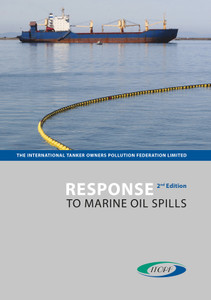
The Marine Environment Protection Committee (MEPC), at its sixty-fifth session, approved the revision of Section II of the Manual on Oil Pollution to update the previous edition and incorporate new information related to contingency planning for offshore installations, sea ports and oil handling facilities.
This edition of Section II builds upon three earlier editions, first published in 1978, and provides a concise summary of the best practices for governments to follow when establishing a National Response System and developing or revising their national oil spill contingency plans.
The Manual on Oil Pollution has the following sections:
Section I – Prevention (2011 Edition)
Section II – Contingency Planning (this publication)
Section III – Salvage (1997 edition)
Section IV – Combating Oil Spills (2005 edition)
Section V – Administrative Aspects of Oil Pollution Response (2009 edition)
Section VI – IMO Guidelines for Sampling and Identification of Oil Spills (1998 edition)
There are several publications that contain marine oil spill contingency planning guidance for organizations that produce, handle, transport, or store oil products. This revised edition of Section II of the International Maritime Organization’s Manual on Oil Pollution is published to assist governments in establishing a National Response System and preparing a National Contingency Plan for preparedness and response. With a well-developed National Response System, clearly defined policies and responsibilities and a regularly exercised National Contingency Plan, a country may encourage development of oil infrastructure while reducing potential consequences of oil spills that might occur during the exploration, production, transport, transfer or storage of crude oil and refined oil products.
Taking into consideration the latest developments in knowledge, regulations and practices established at IMO and other global and national organizations, this edition is comprised of five chapters and seven appendices. The chapters and appendices aim to assist governments that are establishing a National Response System and a National Contingency Plan; however, there is value herein for refining and further developing existing systems.
This revised edition is intended to be a concise guideline; appendix 7 provides a list of relevant documents for a more exhaustive examination of many of the topics addressed herein.
Chapter 1 – Establishing a National Preparedness and Response System
1.1 International conventions
1.2 National legislation and regulations
1.3 Designated Competent National Authority
1.4 National operational contact point
1.5 Requesting or rendering assistance
1.6 National Oil Spill Contingency Plan
1.7 Pre-positioned oil spill response equipment
1.8 Exercises, training and health and safety
1.9 Industry oil pollution contingency plans
1.10 Oil spill response resource coordination
1.11 Tiered response
1.12 National oil spill response management system
1.13 Assessing oil spill response preparedness
Chapter 2 – A National Oil Spill Contingency Plan
2.1 Responsibilities of the Competent National Authority
2.2 Oil spill risk assessment
2.3 Notification, reporting and alerting
2.4 Oil spill assessment
2.5 National oil spill response management organization
2.6 Sensitivity maps
2.7 Response resources
2.8 Response strategies
2.9 Waste management
2.10 Demobilization and termination of response
2.11 Restoration and post-spill monitoring
2.12 Training, exercising, record keeping and plan updating requirements
Chapter 3 – Contingency plans for oil handling facilities, ports and offshore installations
3.1 Risk analysis
3.2 Tier definitions and minimum planning requirements
3.3 Incident reporting
3.4 Response time frames
3.5 Spill response organization
3.6 Plan implementation and response strategies
3.7 Waste management
3.8 Decontamination
3.9 Demobilization and termination of response
3.10 Special considerations for offshore exploration and production installations
3.11 Integration of industry and government response management structures
3.12 Contingency plan testing and update requirements
Chapter 4 – International cooperation
4.1 Applicable international agreements and code
4.2 Cooperation between participating governments
4.3 Reporting international oil spills and related communications
4.4 Logistics of multilateral agreements
4.5 Administration
4.6 Review and update of a Multilateral Contingency Plan
Chapter 5 – Intervention and cost recovery
5.1 National considerations
5.2 Regulatory framework for Liability and Compensation
5.3 Liability and compensation – Core principles
5.4 Preparation of claims from oil pollution
5.5 Submission, assessment and settlement of the claim
Appendix 1 – Sample legislation establishing a National Response System
Appendix 2 – Sample outline of a national oil pollution contingency plan
Appendix 3 – Sample outline of an industry contingency plan
Appendix 4 – Sample outline for an international oil spill cooperation plan
Appendix 5 – International pollution reporting systems
Appendix 6 – Guidelines for identifying response resources
Appendix 7 – References and further reading
A??s a specialized agency of the United Nations, IMO is the global standard-setting authority for the safety, security and environmental performance of international shipping. Its main role is to create a regulatory framework for the shipping industry that is fair and effective, universally adopted and universally implemented.
In other words, its role is to create a level playing-field so that ship operators cannot address their financial issues by simply cutting corners and compromising on safety, security and environmental performance. This approach also encourages innovation and efficiency.
Shipping is a truly international industry, and it can only operate effectively if the regulations and standards are themselves agreed, adopted and implemented on an international basis. And IMO is the forum at which this process takes place.
- Number of Pages:
- 103
- ISBN:
- 9789280116663
- Published Date:
- July 2018
- Book Height:
- 250 mm
- Book Width:
- 210 mm
- Author:
International Maritime Organization
- Preview:
- Yes
- Binding Format:
- Paperback





